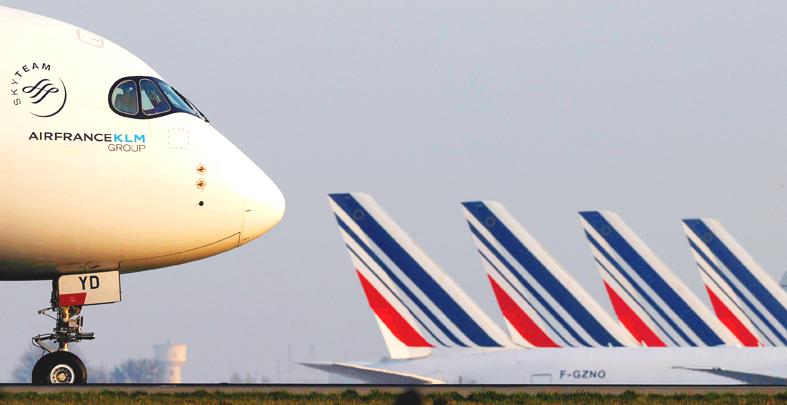The French government has reached a deal with the European Commission allowing it to inject fresh money into flagship airline Air France, it said on Sunday, as the airline’s finances creak under the effects of COVID-19 restrictions
The agreement follows weeks of negotiations with the EU’s executive, which must ensure that state aid does not give companies an unfair advantage.
“We have an outline agreement with European Commissioner Margrethe Vestager about new financial aid for Air France,” French Minister of Finance Bruno Le Maire said on the RTL political broadcast Le Grand Jury.

Photo: Reuters
Air France, of which the French government owns 14.3 percent, will have to give up “a certain number” of slots at Orly, Paris’ second-largest airport after the Charles de Gaulle airport, in return for the green light from Brussels, Le Maire said.
Air France posted a 7.1 billion euro (US$8.34 billion) loss last year as its business, like those of the rest of the world’s airlines, was affected by restrictions which all but grounded global air traffic.
Le Maire would not be drawn on the amount of new funds to be given Air France, saying this was part of discussions to be held with the airline, whose board needs to vote on the deal and was to meet today.
The agreement with the Commission was “very good news for Air France and for the whole French aviation sector,” Le Maire said, adding that negotiations had been “tough.”
The minister declined to say how many slots at Orly Air France would have to give up, but said it would be fewer than the 24 that the commission had initially asked for.
The French government has already given “a lot of help” to Air France to weather the COVID-19 crisis with an initial sum of 7 billion euros and would “not sign a blank check” this time around, Le Maire said.
“There are tens of thousands of jobs involved. Air France is strategic for our country,” he said.
The carrier must become more competitive and continue to reduce carbon emissions, he said.
“The taxpayer is making an effort, and Air France must also make an effort,” Le Maire added.
A European Commission spokesperson said that the executive was in contact with the French government but could not “predict the timing or outcome of these contacts.”
According to EU rules, any government granting more than 250 million euros in aid to a company with “significant market power” had to propose additional measures to safeguard competition, the spokesperson said.
Any fresh capital for Air France would be scrutinized not only by the EU, but also by the carrier’s competitors, which want to make sure that the playing field remains level.
The Air France plan comes as France faces rising deficits and debt because of a weaker economic rebound than hoped.
The annual deficit, which has spiraled as French President Emmanuel Macron’s government tries to prop up the struggling economy with massive spending, is expected to reach 9 percent of GDP this year, Le Maire said.
This compares with an 8.5 percent estimate included in the government’s budget plan for this year, and a three percent deficit limit that EU members must usually respect, but have swept aside as they deal with COVID-19.

Taiwan Semiconductor Manufacturing Co (TSMC, 台積電) last week recorded an increase in the number of shareholders to the highest in almost eight months, despite its share price falling 3.38 percent from the previous week, Taiwan Stock Exchange data released on Saturday showed. As of Friday, TSMC had 1.88 million shareholders, the most since the week of April 25 and an increase of 31,870 from the previous week, the data showed. The number of shareholders jumped despite a drop of NT$50 (US$1.59), or 3.38 percent, in TSMC’s share price from a week earlier to NT$1,430, as investors took profits from their earlier gains

In a high-security Shenzhen laboratory, Chinese scientists have built what Washington has spent years trying to prevent: a prototype of a machine capable of producing the cutting-edge semiconductor chips that power artificial intelligence (AI), smartphones and weapons central to Western military dominance, Reuters has learned. Completed early this year and undergoing testing, the prototype fills nearly an entire factory floor. It was built by a team of former engineers from Dutch semiconductor giant ASML who reverse-engineered the company’s extreme ultraviolet lithography (EUV) machines, according to two people with knowledge of the project. EUV machines sit at the heart of a technological Cold

CHINA RIVAL: The chips are positioned to compete with Nvidia’s Hopper and Blackwell products and would enable clusters connecting more than 100,000 chips Moore Threads Technology Co (摩爾線程) introduced a new generation of chips aimed at reducing artificial intelligence (AI) developers’ dependence on Nvidia Corp’s hardware, just weeks after pulling off one of the most successful Chinese initial public offerings (IPOs) in years. “These products will significantly enhance world-class computing speed and capabilities that all developers aspire to,” Moore Threads CEO Zhang Jianzhong (張建中), a former Nvidia executive, said on Saturday at a company event in Beijing. “We hope they can meet the needs of more developers in China so that you no longer need to wait for advanced foreign products.” Chinese chipmakers are in

AI TALENT: No financial details were released about the deal, in which top Groq executives, including its CEO, would join Nvidia to help advance the technology Nvidia Corp has agreed to a licensing deal with artificial intelligence (AI) start-up Groq, furthering its investments in companies connected to the AI boom and gaining the right to add a new type of technology to its products. The world’s largest publicly traded company has paid for the right to use Groq’s technology and is to integrate its chip design into future products. Some of the start-up’s executives are leaving to join Nvidia to help with that effort, the companies said. Groq would continue as an independent company with a new chief executive, it said on Wednesday in a post on its Web